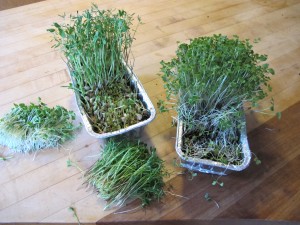Growing Windowsill Greens
I grow a lot of my own food and strive to be as self-sufficient at possible. So I store, freeze, can and dehydrate lots of garden produce each summer and fall. I hate buying produce at a store if I can grow it myself, but so far I’ve never been able to produce winter greens or tomatoes. Not until recently, however, when I read Peter Burke’s wonderful new book, Indoor Gardening: Seed to Salad in Seven Days .And although I still can’t produce my own tomatoes indoors, I’ve grown edible greens on the windowsill. It’s easy.
Here’s the basic plan: you can grow sprouts of peas, broccoli, radish, buckwheat, sunflower or just about anything edible without lights or special equipment. You need a source of organic seeds, some soil-less potting soil, a little compost and some kelp meal, and some shallow containers (without holes in the bottom). I used “disposable” aluminum bread pans, the kind you would use to make a loaf of zucchini bread to give away, 4” wide and 8” long. Oh yes, and a windowsill, but it need not even be terribly bright.
I followed Peter Burke’s directions and soaked seeds overnight before using. A 4-by-8 inch container needs 2 tablespoons of large seeds like beans or sunflowers, or 2 teaspoons of small seeds like broccoli or radish. If you use the 3-by-6 inch size baking tin, you need only half that amount.
Meanwhile, I measured out a gallon of soilless potting mix into a plastic zipper bag and added 3 ½ cups of water. You need to do this ahead of time as the peat moss in the soilless mix is usually very dry, and it takes time to absorb the water. Peter recommends using a juice pitcher for measuring and pouring the mix. He starts sprouts every day, so he makes up lots of bags of mix at once.
The seeds are going to be placed on the surface of the “soil”, not planted in it. Their roots will go straight to the bottom of the container, so that is where the book says to place your “fertilizer” – 2 tablespoons of compost and 1 teaspoon of dried kelp (he pre-moistens it, though I didn’t). Add the moistened seed starting mix on top of that, leaving half an inch or so of space near the lip of the container.
After soaking the seeds for 6-24 hours, drain them by pouring them into a kitchen sieve, and rinse. Then spoon the seeds over the soil surface and use the back of the spoon to move them around, distributing them evenly. These seeds then need 4days or more to germinate and start growing. They should be in the dark for that phase. Peter Burke explains that folding a piece of newspaper so it is 6 layers thick and then soaking it will make a good cover to help keep out light and keep seeds lightly moist.
You need a warm, dark place to keep the containers during the next phase. I stored mine in a cool cupboard that was only 55 degrees, and they did not germinate in the 4 days that Peter suggested was to be expected. So I added some heat by putting an electric heat mat (the kind I use for starting seeds in flats) in the cupboard. That way I quickly got the temperature up to 65 degrees or more and they germinated in a couple of days. I left them in the dark for another day or two, as recommended, and the sprouts pushed the newspaper cover up and got 2 inches tall.
Then comes the fun part. I removed the newspaper and put the baking pans on the windowsill. The sprouts greened up almost immediately and started a growth spurt. Each day I marveled at this bright green food source growing on my windowsill, and gave a daily watering to keep the soil mix from drying out. Within 4 days they were 4 inches tall and ready for harvesting. Peter Burke explains in his book that you should harvest when sprouts are 4-7 inches tall and before they develop a second set of leaves, which can be bitter.
I gather that Peter Burke eats salads made entirely of sprouts, all kinds of sprouts. I mixed mine with some early spring lettuce mix from the store, and added cucumber and other standard salad ingredients. I like the flavor of the sprouts, and like watching them grow.
To learn more or to see plenty of very good color photos of the process, go to Peter Burke’s web site, www.thedailygardener.com and order his book. It’s available from him for $35 at P.O. Box 13, Calais, VT 05648.
As a grandfather and a former school teacher, I am always thinking of ways to get kids interested in growing things. Growing windowsill greens would seem to be a perfect Science Fair project, or a way to kids to like growing – and eating – healthy vegetables. And for the rest of us? Growing good food made quick and easy.
Henry Homeyer is the author of 4 gardening books, and a new children’s novel called Wobar and the Quest for the Magic Calumet. Learn more at www.henryhomeyer.com.



